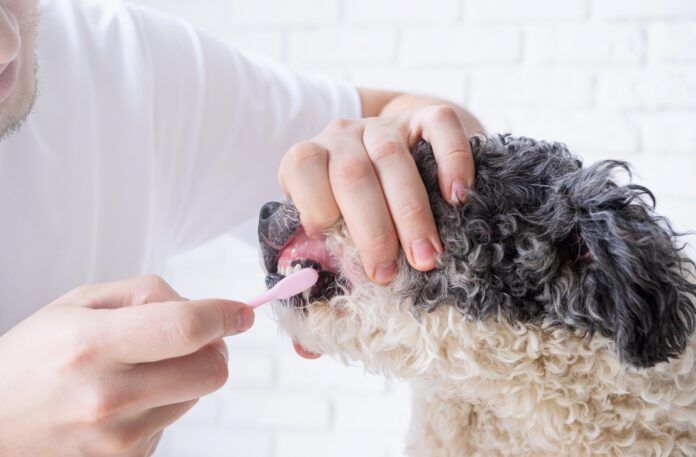
Most dog owners are disappointed to hear that brushing their dogs’ teeth is a necessary part of maintaining the health of their dogs. Regular oral examinations and professional cleaning by a veterinarian is also needed, but this professional service is an adjunct to, not a replacement for, regular tooth brushing.
We brush our teeth at least twice a day. You may have noticed that the surface of your teeth will start to feel fuzzy when you get close to the next time you are due to brush your teeth. When you eat and drink, bacteria in your mouth begin to accumulate on the surface of your teeth. This creates a biofilm, which feels fuzzy when you run your tongue over it.
As the biofilm accumulates layer upon layer, plaque is formed – both on the surface of your teeth and below the gumline. Over time, plaque that is not removed by brushing and flossing becomes hardened and mineralized, forming dental calculus.
This same process occurs in your dog’s mouth. It does not matter if your dog eats canned food, dry kibble, frozen fresh food, or a home-cooked diet. Any food in the mouth promotes the production of biofilm, plaque, and dental calculus. The exception to this are kibble diets that have been specifically formulated to remove plaque and tartar accumulation, such as the Hills t/d prescription diet.
Brushing your dog’s teeth twice a day promotes good oral health and minimizes the risk of developing periodontal disease. However, even brushing just three times a week has been shown to provide a benefit.
How to brush your dog’s teeth
The key to introducing a dog to tooth brushing is to take it slow. Start with just rubbing your finger or a soft damp washcloth on the outer surface of your dog’s front teeth. Rub with a back and forth motion and concentrate on where the teeth meet the gums.
Once your dog is accustomed to this routine, start advancing toward the back teeth. The teeth on your dog’s upper jaw overhang the teeth on his lower jaw, so you may need to open his mouth slightly to rub the lower teeth.
If your dog will let you open his mouth to access the middle and inner surfaces of his teeth, add this into the tooth-rubbing routine. Many dogs are resistant to this, so if this is a game-changer for him, then don’t push it. You want the tooth-brushing experience to be a good one, not one that he dislikes.
Now you can move on to the next step. Introduce a soft toothbrush or a finger brush to the routine. Again, start with the front teeth and gradually move to the back teeth. You can use a toothbrush that is made for dogs, a rubber brush that fits over the end of your finger, or a soft toothbrush made for human babies. If your dog objects to the toothbrush but is still comfortable with a damp washcloth, you can use the washcloth as your brush.
The final step is to introduce dog toothpaste. Dog toothpaste comes in many flavors, such as chicken, beef, peanut butter, and mint. Put a little dab of toothpaste on your finger and allow your dog to investigate the smell and flavor. If he reels away from it, try a different flavor!
Do not use human toothpaste; it is not meant to be swallowed. We are not able to instruct our dogs to “rinse and spit,” so we need to use a toothpaste that is safe for his gastrointestinal tract.
For even more toothbrushing tips, click here.
How to select a dog toothpaste and toothbrush

When selecting a dental health product, look for the seal of approval from the Veterinary Oral Health Council (VOHC).
Look at the toothpaste you use for yourself and look at the label. You will probably notice a small emblem on the label that states “ADA Seal of Acceptance.” This means that the toothpaste has met the standards set forth by the American Dental Association to benefit your oral health.
Your canine companions have a similar organization looking out for their oral health. The VOHC was formed in 1997 and has the support of the Academy of Veterinary Dentistry and the American Veterinary Dental College.
The VOHC does not test dental products. Instead, they accept applications from manufacturers of dental products to receive the seal of approval. The VOHC completes a rigorous review of the scientific studies backing the manufacturer’s claims. If the product meets the stringent standards set forth by the VOHC, then the product is accepted and is added to the VOHC list of approved products.
This is a voluntary program. A product that does not carry the VOHC seal of approval does not mean that the product does not work. But a product that has the VOHC seal of approval gives you peace of mind that the product has met a set of stringent standards, is safe, and is proven to work as intended.
Look for the “VOHC Accepted” logo when selecting a dental product for your dog. A list of approved products can be found here.
Alternatives to tooth-brushing
If your dog really objects to having his teeth brushed, there is no need for despair. There are several treats, chews, and additives that you can put in your dog’s food or water to help minimize the production of plaque in your dog’s mouth. Twice daily tooth brushing remains the gold standard for at-home dental care, but using one of these alternatives will provide some benefit to your dog.
There are many treats, chews, and food/water additives that claim to be beneficial for your dog’s oral health.
Brushing your dog’s teeth is not enough!
It is important to note that starting an at-home dental care plan after periodontal disease has been diagnosed will not reverse that disease or stop its progression. If your veterinarian suspects that your dog has periodontal disease, the first step in addressing that problem is a professional dental cleaning and oral exam. Then you can successfully start an at-home dental care program once your dog’s mouth is a clean and healthy slate.






A few tips and tricks I have used over the years, teaching all 4 of my Australian Shepherds to accept dental care….
1). I first started with my little boy’s retired Spider Man battery powered spin brush, when it got a bit too worn for him. Nowadays, I use rechargeable spin brushes with replaceable heads. Puppies tend to chew on them at first; if they crack anything, you can easily and cheaply replace just the head.
2). Start the process of having your puppy accept the brush, without starting its movement. Three of my pups first encounter with a spin brush used real peanut butter on the brush (the other dog preferred squirt cheese). Let them lick the brush clean, several times, before you start its movement. The pup will already associate it with yummy treats, so the new spinning sensation isn’t scary.
3). Find a dog toothpaste in the flavor of the treat you used to get your dog to accept the brush. Yes, in my case, I use peanut butter or cheese flavored dog toothpastes. The transition between real peanut butter to peanut butter flavor was seamless. And I had pups that looked forward to the tasty treat of tooth brushing!
4). I was able to introduce dental scaling tools the same way – but could use just the toothpaste, instead of going back to the original. Over the years, I’ve learned that my dogs will generate far more plaque when they eat food with more carbohydrates, than when they are eating primarily raw food.
Teaching your dog it’s ok for you to examine EVERY part of them, can be vitally important. I’m reminded of a friend’s dog that somehow managed to get a hunk of stick lodged between its big molars on top. He had developed very stinky breath, and only when my friend stuck her hand into his mouth, did she find the source of the smells! The dog let us remove the stick, and later that day her vet verified the stick had started an infection in the roof of the dog’s mouth, which responded well to treatment.
As a trainer, I remind folks that dogs solve problems with their mouths, and all 42 teeth. Being able to check those teeth safely, should be something every owner does regularly!
We agree with Patricia above regarding the starches in dry foods contributing to tartar development, and our raw fed dogs also have very little tartar on their teeth.
And while Hills claims that t/d has some sort of matrix that scrubs teeth, we are highly skeptical. Would you feed any kind of cookie to your kid to brush his or her teeth?? And how many dogs really chew that much?
Not to mention the ingredients in T/D are abysmal (Brewers yeast, Corn, Chicken by-product meal, Powdered cellulose (tree bark), Chicken fat, Soy are first 6 ingredients) the price is astronomical ($114 at a big box,) and one must feed over twice the amount per day than most high quality foods (50lb dog needs 4.5 cups/day; many much better foods only require 2 cups/day do to more digestible ingredients and less fillers.)
Too bad so many vets (and contributors to WDJ) are so brainwashed by Hills that they refuse to do their own research on nutrition.
We highly recommend sea kelp dental powders. ProDen Plaqueoff is one, and there are others, which work very well to help eliminate plaque and tartar. In fact some of our local vets have thought that their clients had gone to a different vet to have their teeth cleaned after being on ProDen for a few months.